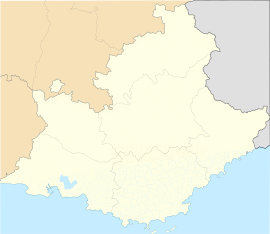Roquevaire
Roquevaire
Ròcavaira (Occitan) | |
|---|---|
 A view of Roquevaire | |
 Coat of arms | |
show Location of Roquevaire | |
 Roquevaire | |
| Coordinates: 43°21′00″N 5°36′19″E / 43.35°N 5.6053°ECoordinates: 43°21′00″N 5°36′19″E / 43.35°N 5.6053°E | |
| Country | France |
| Region | Provence-Alpes-Côte d'Azur |
| Department | Bouches-du-Rhône |
| Arrondissement | Marseille |
| Canton | Aubagne |
| Intercommunality | Aix-Marseille-Provence |
| Government | |
| • Mayor (2020–2026) | Yves Mesnard |
| Area 1 | 23.83 km2 (9.20 sq mi) |
| Population (Jan. 2018)[1] | 8,858 |
| • Density | 370/km2 (960/sq mi) |
| Time zone | UTC+01:00 (CET) |
| • Summer (DST) | UTC+02:00 (CEST) |
| INSEE/Postal code | 13086 /13360 |
| Dialling codes | (+33) 04 |
| Elevation | 134–732 m (440–2,402 ft) (avg. 160 m or 520 ft) |
| 1 French Land Register data, which excludes lakes, ponds, glaciers > 1 km2 (0.386 sq mi or 247 acres) and river estuaries. | |
Roquevaire (French pronunciation: [ʁɔk(ə)vɛʁ]; Occitan: Ròcavaira) is a commune in the Huveaune valley between Aubagne and Auriol in the Bouches-du-Rhône department in the Provence-Alpes-Côte d'Azur region of Southern France. In 2017, it had a population of 9,003. Its inhabitants are called Roquevairois and Roquevairoises.
Geography[]
The villages of Lascours, Pont-de-l'Étoile and Pont-de-Joux are located within the commune of Roquevaire. In 2023, Roquevaire will be served by two stations of the Aubagne tramway when the northern Line T extension opens.
Tourism[]
The main attraction is the organ in the Saint Vincent Church, which is the largest organ in France. The town features an international organ festival in September.
Population[]
|
|
See also[]
References[]
- ^ "Populations légales 2018". INSEE. 28 December 2020.
| Wikimedia Commons has media related to Roquevaire. |
Categories:
- Communes of Bouches-du-Rhône


